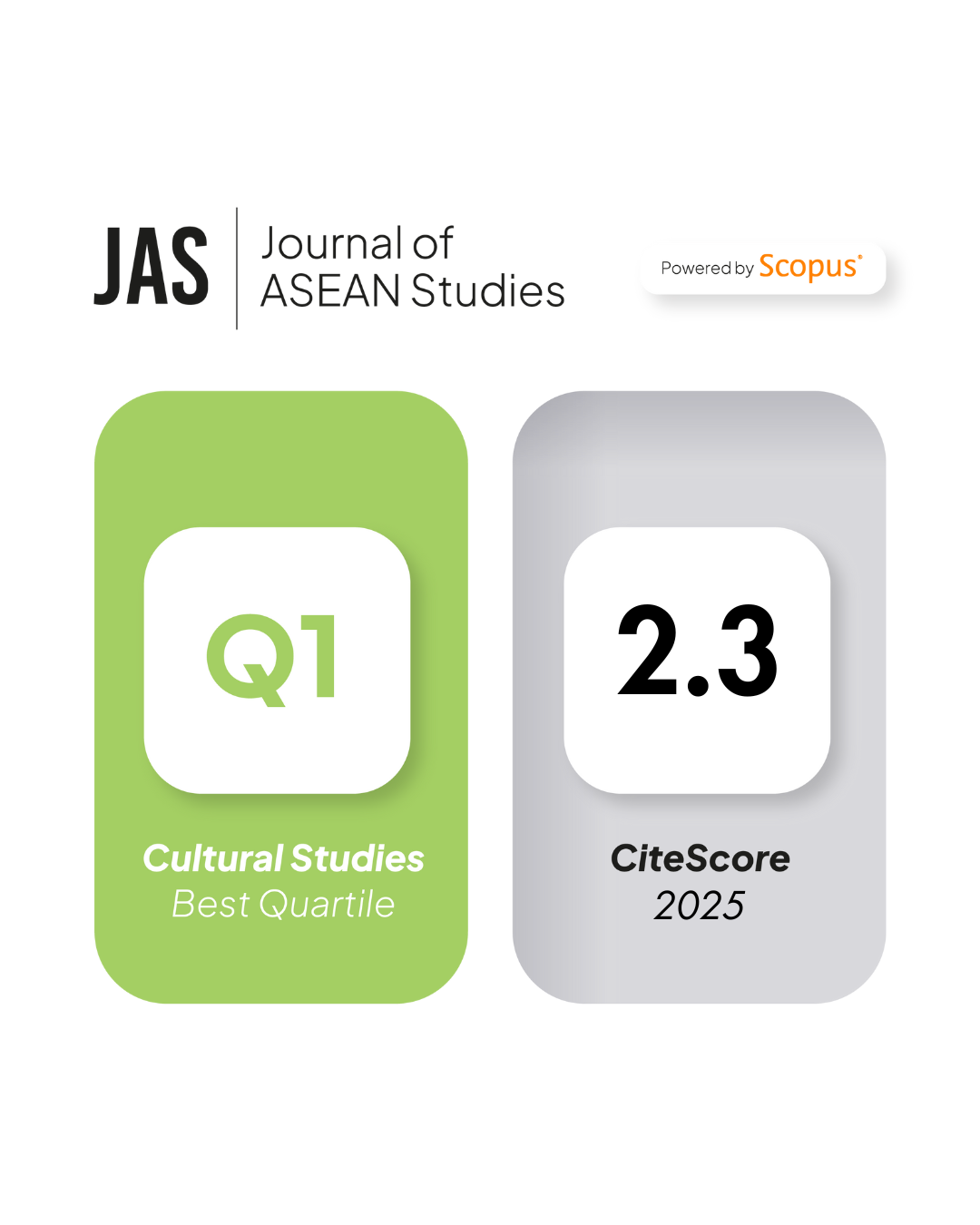Migration between Southeast Asia and Taiwan: Trends, Characteristics and Implications
DOI:
https://doi.org/10.21512/jas.v3i2.842Keywords:
International Migration, Migration and Development, Taiwan, Southeast Asia, Asymmetric InteractionAbstract
The migration of human resources between Southeast Asia and Taiwan is significant, indicating a close bilateral relationship. This study takes the perspective of economic development to examine the migration flows, aiming to explore the migration impacts of differences in societal development. Based on the Taiwan-Southeast Asia relative development status, the study further theorizes the possible migration trends between the two places. Empirically, the investigation focuses on major types of migration from Indonesia, the Philippines, Thailand, and Vietnam to Taiwan, including contract workers, immigrant spouses, professionals and the skilled, as well as students. The Taiwan to Southeast Asia migration covers mainly those migrants induced by Taiwanese investment. According to available information, the migration between Taiwan and Southeast Asia is rather asymmetric, with the Southeast Asia to Taiwan flows far more important than the counter flows. This fact indicates an advantageous position for Taiwan to cultivate relations with the migrant sending nations. It also provides a niche for every source country to work closely with Taiwan in migration management and migrant protection, for the interests of both the places of origin and destination.
References
Athukoraola, Prema-chandra. 2008. ‘Internation Labour Migration and Structure Change in East Asia: trends, patterns and policy issues.’ Asian-Pacific Economic Literature, 20 (1):18-39.
Chen, Hen-Kuang (陳æ†å…‰). 2012. ‘Research by Mainland (Chinese) Scholars: Investment by “Tai Shang†Has Been Major Source of FDI to SE Asian Countries.’ (in Chinese) The Internet News of the Central Daily News (30 Nov.). <http://www.cdnews.com.tw/cdnews_site/docDetail.jsp?coluid=117&docid=101744305>。
Huang, Futao. 2006. ‘Inter- nationalization of Curricula in Higher Education Institutions in Comparative Perspectives: Case Studies of China, Japan and The Netherlands.’ High Education, 51(4): 521-529.
Huang, Hong-Ming and Jenny-Jaw Soong. 2013. ‘ASEAN Migrants: A Boon for Taiwan’s Aging Populace.’ Journal of ASEAN Studies, 1(2): 161-172. Jakarta: Centre for Business and Diplomatic Studies, Bina Nusantara University.
Huang, Shirlena and Brenda S. A. Yeoh, 1996. ‘Ties That Bind: State Policy and Migrant Female Domestic Helpers in Singapore.’ Geoforum, 27(4): 479-493.
IOM, 2008. Situation Report on International Migration in Southeast and East Asia. Bangkok: International Organization for Migration.
Kabinawa, Luh Noyman Ratih Wagiswari. 2013. ‘Economic and Socio-Culture Relations between Indonesia and Taiwan: An Indonesian Perspective, 1990-2012.’ Journal of ASEAN Studies, 1(2): 124-147.
Ku, Samuel C. Y. 2006. ‘Taiwan's Immigrants and Its Economic Relationship with Southeast Asia.’ (in Chinese). Taiwan Journal of Southeast Asian Studies, 3(2): 105- 125.
Ministry of Education Department of Statistics. 2012. ‘Foreign Students in Universities and Colleges in Taiwan,’ (Jan. 6)
<http://www.edu.tw/statistics/content aspx?site_content_sn=29767>
Martin, Philip, Andrew Mason and Ching-lung Tsay 1995. ‘Overview: Labour Migration in Asia.’ ASEAN Economic Bulletin, 12(2): 117-124.
Paramitaningrum. 2013. ‘Enhancing People-to-People Cooperation between ASEAN and East Asia Countries through Counterparts: The Case of Indonesian Student in Taiwan.’ Journal of ASEAN Studies, 1(2): 48-160.
Peng, Lien-yi (å½æ¼£æ¼ª). 2008. ‘The Demand for Tai Kan in SE Asian Has Increased by 80 Percent.’ (in Chinese) Coolloud <http://www.coolloud.org.tw/node/19193>。
Perkins, Dwight H. 2014. East Asia Development: Foundations and Strategies. Cambridge, Mass, U.S.A.: Harvard University Press.
Song, Bieng-zhong (å®‹ç§‰å¿ ). 2012. ‘The second Generation of Tai Kan are in Hot Demand,’ (in Chinese) Want China Times. <http://xn--3iwu91ckkdt6v.xn—kpry57d/home.php?mod=space&uid=22&do=blog&id=581>。
Thurow, Lester C. 2003. Fortune Favors the Bold: What We Must Do to Build a New and Lasting Global Prosperity. New York, NY: Harper Collins Pub.
Tsai, Hung-Jeng. 2010. ‘Unbalance in Demand for and Supply of Highly Educated Manpower and Its Policy Implications.’ (in Chinese), Humanities and Social Sciences Newsletter Quarterly, 11(3): 36-41.
Tsai, Pan-long and Ching-lung Tsay. 2012. ‘Economic Development, Foreign Direct Investment, and International Labour Migration: an Analytical Framework for the “Investment-Migration-Development Path.â€â€™ (in Chinese) Taiwan Journal of Southeast Asian Studies, 9(1): 3-24.
Tsai, Pan-long and Ching-lung Tsay. 2004. ‘Foreign Direct Investment and International Migration in Economic Development: Indonesia, Malaysia, Philippines and Thailand.’ pp: 94-136 (Ch. 4) in International Migration in Southeast Asia (ed. Aris Ananta and Evi N. Arifin). Singapore: Institute of Southeast Asian Studies.
Tsay, Ching-lung. 2015. ‘Migration, Marriage and Work: from “Contract Workers†to “Immigrant Spourses†among Thais in Taiwan.’ (manuscript), Institute of Asian Studies, Tamkang University, Taiwan.
Tsay, Ching-lung. 2008. ‘Aggregate Characteristics and Developmental Trends of Immigrant Spouses in Taiwan.’ (in Chinese), The 2008 Conference on Southeast Asian Studies in Taiwan. Taichung: Asia University.
Tsay, Ching-lung. 2007. ‘Recognizing Workers’ Interests in Taiwanese Labour Importation Policy.’ (in Chinese). Chapter 5 (pp. 155-177) in Studies on Foreign Workers in Taiwan (ed. Joan Lo). Taipei: Institute of Economics, Academia Sinica.
Tsay, Ching-lung. 2004. ‘Marriage Migration of Women from China and Southeast Asia to Taiwan.’ pp. 173-191 (Ch. 7) in (Un)tying the Knot: Ideal and Reality in Asian Marriage (ed. Gavin W. Jones and Kamalini Ramdas). Singapore: Asian Research Institute, National University of Singapore.
Tsay, Ching-lung. 2003. ‘International Labor Migration and Foreign Direct Investment in East Asian Development: Taiwan as Compared with Japan,’ pp.131-168 (Ch.6) in Trade, Investment and International Labor Migration in APEC Member Economies (edited by Yasuko Hayase), Chiba, Japan: Institute of Developing Economies, JETRO.
Tsay, Ching-Lung. 2002. ‘Labor Migration and Regional Changes in East Asia: Outflows of Thai Workers to Taiwan.’ Southeast Asian Studies 40(3): 372-394 (Special Issue on Population and Globalization edited by Andrew Mason, Sumner La Croix and Abe Shigeyuki). Kyoto: Center for Southeast Asian Studies, Kyoto University.
Tsay, Ching-lung. 1995a. ‘Taiwan: Labour Shortage.’ pp.197-216 (Ch.8) in Asian NIEs and the Global Economy: Industrial Restructuring and Corporate Strategy in the 1990s (edited by Gordon Clark and Won Bae Kim). Baltimore: The Johns Hopkins University Press.
Tsay, Ching-lung. 1995b. ‘Taiwan: Labour Importer.’ ASEAN Economic Bulletin, 12(2): 175-190.
Tsay, Ching-lung. 1992. ‘Clandestine Labor Migration to Taiwan’ Asian and Pacific Migration Journal 1(3-4): 637-655.
Tsay, Ching-lung, Kung-Jung Cheng and Deng-shing Huang. 2012. ‘Managing the Small Ethnic Enterprise: Manpower, Capital and Networks.’ (in Chinese), Chapter 4 (pp. 75-120) in Deng-shing Huang, Ching-lung Tsay and Michael Hsin-huang Hsiao (eds.) The Ethnic Economy of Immigrant Spouses from Vietnam to Taiwan. Taipei: Center for Asia-Pacific Area Studies, Academia Sinica.
Wang, Hong-zen. 2001. ‘Social Stratification, Vietnamese Partners Migration and Taiwan Labour Market.’ (in Chinesse). Taiwan: A Radical Quarterly in Social Studies, 41: 99-127.
Wang, Lih-li (王立禮). 2003. On the Investment Stages and Management Strategies of “Tai shang†in China: with Comparisons to the Investment by “Tai Shang†in Southeast Asia. (in Chinese) Ph.D. Dissertation, Beijing: Department of History, Beijing University





















